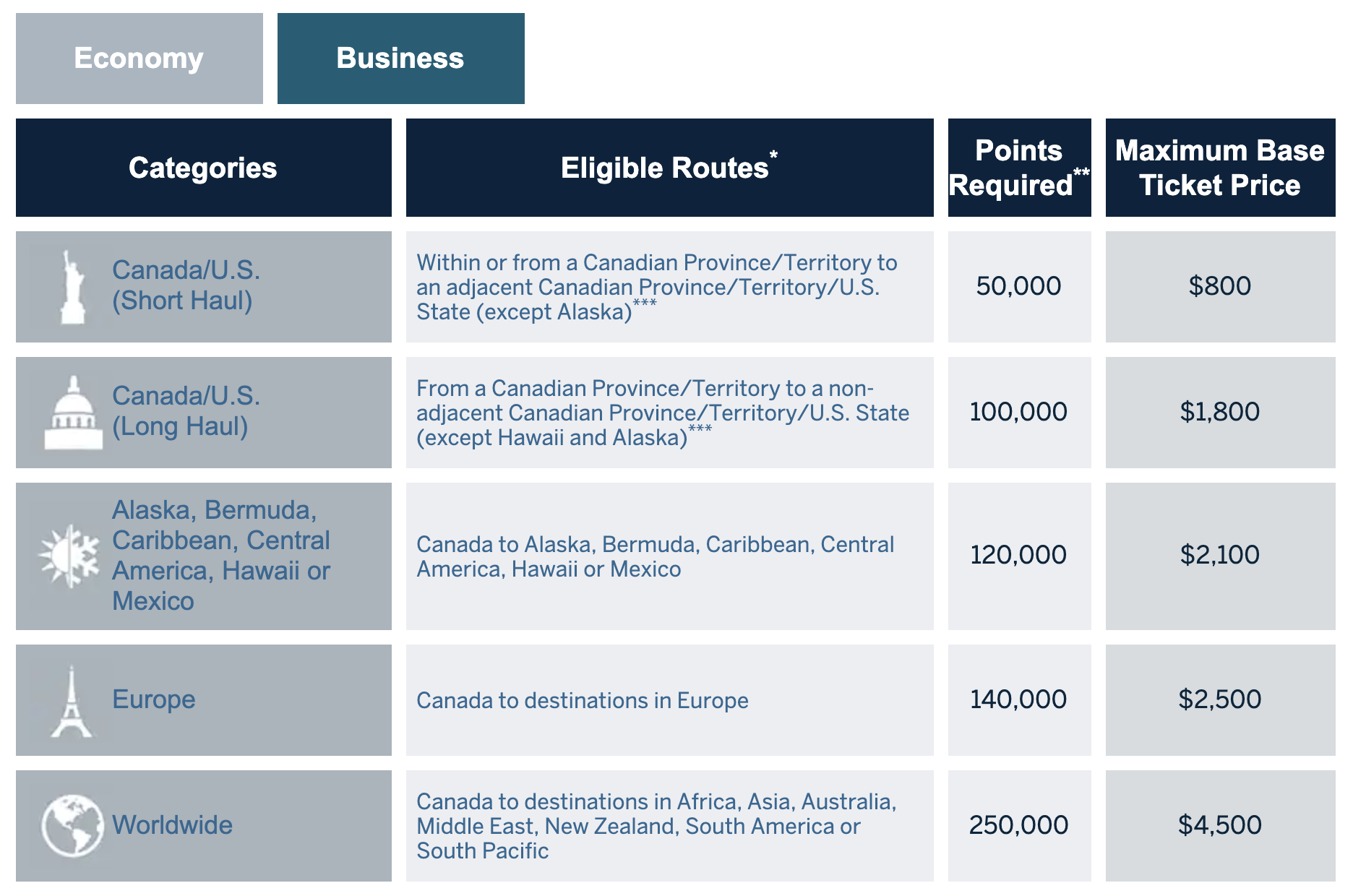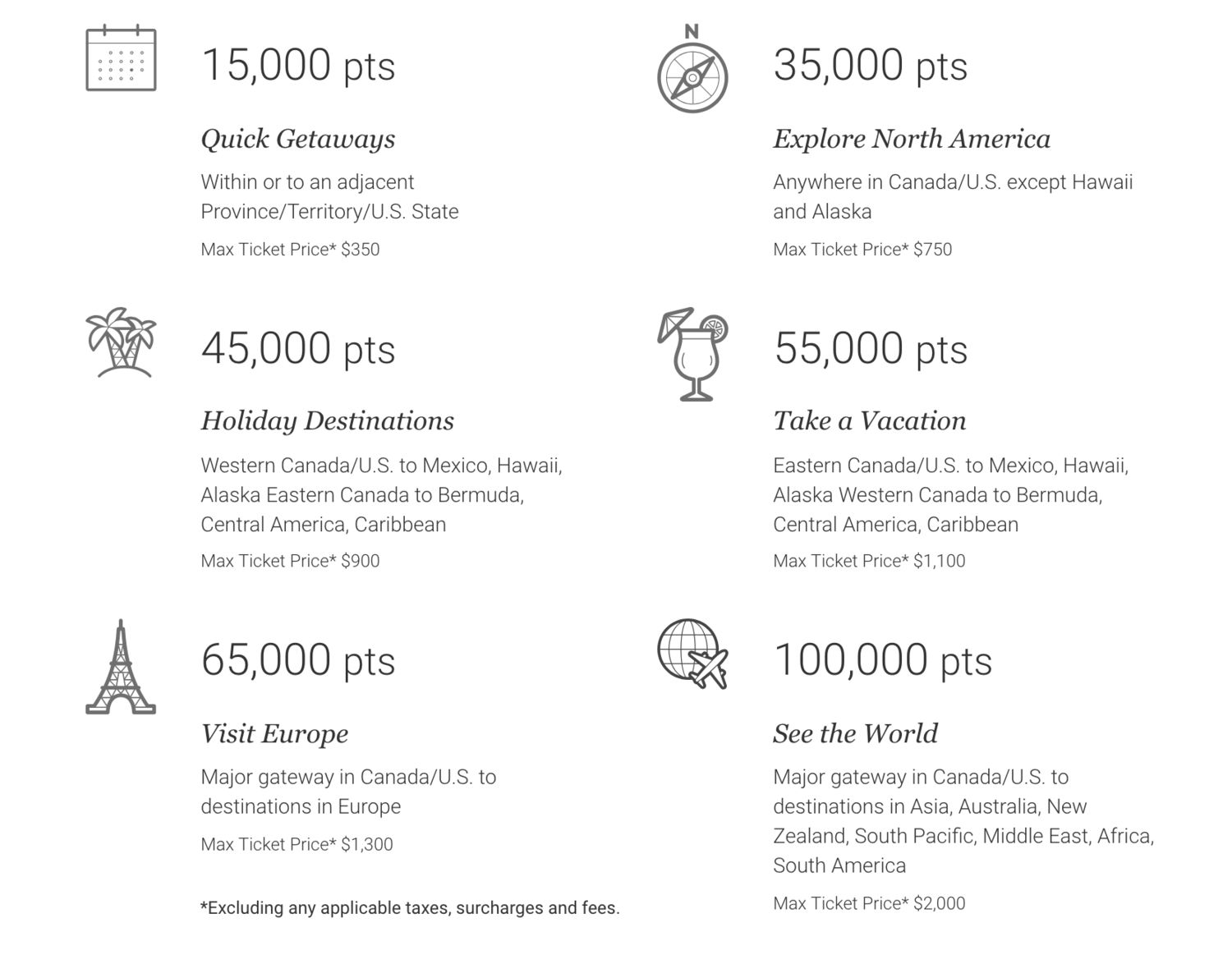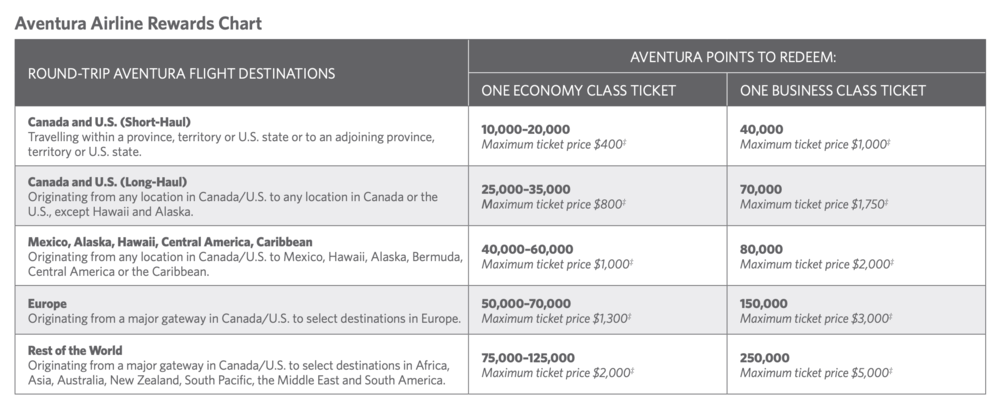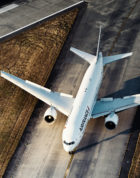By now, we’ve all had a full week’s time to digest the details of Air Canada’s new Aeroplan, which is set to launch on November 8, 2020.
In this post, I wanted to provide further context to the new program’s strengths and weaknesses by situating it among the many other loyalty programs that can be easily accessed by Canadian travellers.
How competitive is the new Aeroplan when compared to other options in the market? Did Air Canada put out a stronger offering than what’s being offered by their peers, or are they about to drive members away to other loyalty programs with the impending change? And how do these answers depend on your overall travel style?
Let’s dive into the numbers and find out.
In This Post
- 1. Travel within Canada/US
- 2. Travel to Sun Destinations
- 3. Intercontinental Travel
- 4. Round-the-World Travel
- Conclusion
1. Travel within Canada/US
As much as we like to enthuse about glamorous international travel here at Prince of Travel, the reality is that around 80% of all Aeroplan redemptions are made on economy class flights within Canada and the US.
This market was therefore a key area of focus for Air Canada when designing the new program, and they knew they had to keep their pricing competitive against the many other points programs offered by Canada’s banks and rival airlines.
How did they do? Let’s take a look at the price points for a handful of domestic and transborder routes across the major currencies that Canadian points collectors might use to book these trips: Aeroplan, Amex Fixed Points Travel, RBC Avion, CIBC Aventura, and WestJet’s Member Exclusive fares.
(Technically, WestJet’s Member Exclusive fares are “on pause” as of June 25, but they still seem to be bookable whenever there’s a WestJet seat sale happening. Moreover, I still think it’d be a worthwhile comparison anyway, and that it could also help us identify the correct strategic response for WestJet when they roll out their new Member Exclusive fares later this year.)
For reference, here are the Amex Fixed Points Travel reward charts:


Here’s the RBC Rewards redemption chart:

Here’s the CIBC Aventura redemption chart:

And without further ado, here’s our comparison chart below.
- Each cell contains two rows:
- Round-trip pricing in economy class
- Round-trip pricing in business class, if applicable
- Since Canada/US awards are likely to be on Air Canada flights, the new Aeroplan’s column will display the full dynamic pricing range.
- All redemptions come with relatively minimal surcharges.
- Aeroplan and WestJet awards can be halved to obtain the one-way pricing; the remaining awards are round-trip only.
- CIBC Aventura’s business class pricing is available only to CIBC Aventura Visa Infinite Privilege cardholders.
- Within each row, I’ve highlighted the best option(s) in green and the worst option in red.
- The current Aeroplan’s pricing is shown in grey, as a point of comparison only.
Toronto | 12K–20K | 15K | 15K | 15K | 10K–20K | 198 WSD |
Toronto | 12K–20K | 15K | 40K | 35K | 25K–35K | – |
Vancouver | 12K–20K | 15K | 15K | 15K | 10K–20K | 198 WSD |
Montreal | 20K–30K | 15K | 40K | 35K | 25K–35K | 250 WSD |
Toronto | 20K–30K | 25K | 40K | 35K | 25K–35K | 250 WSD |
Vancouver | 20K–30K | 25K | 40K | 35K | 25K–35K | 250 WSD |
Toronto | 25K–35K | 25K | 40K | 35K | 25K–35K | 250 WSD |
Toronto | 25K–35K | 25K | 40K | 35K | 25K–35K | 250 WSD |
Vancouver | 35K–50K | 25K | 40K | 35K | 25K–35K | 250 WSD |
As you can see, the new Aeroplan is priced rather favourably for domestic and transborder travel, even taking into account the dynamic pricing range. For most flights of less than 2,750 miles in distance, the new Aeroplan’s pricing is comparable to its predecessor’s and more favourable than the banks’ in-house points currencies.
An exception might be on the short-haul routes between adjoining states and provinces, where CIBC Aventura’s lowest-end pricing of 10,000 Aventura points for a round-trip is also very attractive. However, keep in mind too that Aeroplan co-branded credit card holders and Elite Status members will receive meaningful discounts in the dynamic pricing model, so I think the new Aeroplan may still win out in this regard.
You’ll notice that, for most medium-haul routes across the North American continent, the upper bounds of Aeroplan’s dynamic pricing tend to coincide with the default price point of the big-bank competitors.
That strikes me as a very clear strategic decision on Air Canada’s part: even when flights are busy and you have to pay more Aeroplan points as a result, you still won’t be worse off than if you had gone with your bank’s points instead.
However, while the banks’ points aren’t posing much of a threat, there is one more competitor lying in wait: WestJet Rewards and their Member Exclusive fares.
Particularly as the flown distance increases, WestJet’s fixed pricing of 125 WestJet Dollars for any one-way itinerary across the continent – even a coast-to-coast one like Vancouver–St. John’s – looks more and more attractive.
It’s quite intriguing that WestJet also happens to be revamping its Member Exclusive offering at this moment in time. I’d remind them of the old adage: “If it ain’t broke, don’t fix it.”
Sure, WestJet should definitely consider evolving the Member Exclusive fares, adding new features to the program, and allowing Dreamliner business class redemptions… but as long as they keep that fixed price of 125 WestJet Dollars one-way within Canada and the US, I think it’s safe to say that their members will be extremely happy.
2. Travel to Sun Destinations
After domestic and transborder trips, let’s look at flights to Sun destinations, which is another very popular item that the bulk of Aeroplan members might look to redeem points for.
Looking among the same programs as before, here’s our comparison chart below.
- Each cell contains two rows:
- Round-trip pricing in economy class
- Round-trip pricing in business class, if applicable
- Since Sun destination awards are likely to be on Air Canada flights, the new Aeroplan’s column will display the full dynamic pricing range.
- All redemptions come with relatively minimal surcharges.
- Aeroplan and WestJet awards can be halved to obtain the one-way pricing; the remaining awards are round-trip only.
- CIBC Aventura’s business class pricing is available only to CIBC Aventura Visa Infinite Privilege cardholders.
- Within each row, I’ve highlighted the best option in green and the worst option in red.
- The current Aeroplan’s pricing is shown in grey, as a point of comparison only.
Toronto | 20K–30K | 40K | 50K | 45K | 40K–60K | 498 WSD |
Vancouver | 25K–35K | 40K | 50K | 45K | 40K–60K | 498 WSD |
Toronto | 25K–35K | 40K | 50K | 45K | 40K–60K | 498 WSD |
Vancouver | 25K–35K | 45K | 50K | 45K | 40K–60K | 498 WSD |
Toronto | 35K–50K | 45K | 50K | 55K | 40K–60K | 498 WSD |
Again, the new Aeroplan proves extremely competitive for Sun destinations, and in fact, the pricing has generally grown more favourable compared to the current Aeroplan.
In the past, Aeroplan’s weakness when compared to the big banks’ programs is that it had very limited award availability. A user could’ve easily become frustrated with the fact that no direct flights were available with Aeroplan, and would therefore turn to a program like RBC Rewards or CIBC Aventura instead, where they can simply “buy” the direct Air Canada flight using the fixed-price redemption chart.
The new Aeroplan addresses this concern with last-seat availability on Air Canada flights. Just like before, even at the higher ends of the published ranges, the pricing remains favourable compared to what’s offered by Amex, RBC, CIBC, and even WestJet as well.
As I had mentioned in the Winners & Losers article, infrequent travellers who might only want to take a few sunny vacations per year with their families are really coming out ahead here, and have very good reasons to go with Aeroplan instead of their banks’ in-house points programs going forward.
3. Intercontinental Travel
While the new program’s solid value for travel around North America is all well and good, the truth is that most Aeroplan members who are looking to squeeze maximum value out of the program are more interested in using Aeroplan points to fund international flights, especially in premium cabins. What does the picture look like in this regard?
For this comparison, we’ll swap out Amex Fixed Points Travel, RBC Avion, CIBC Aventura, and WestJet Rewards for a different trio of loyalty programs that are easily accessible in Canada and are commonly used to redeem for international flights: Alaska Mileage Plan, British Airways Avios, and Cathay Pacific Asia Miles.
Here’s our comparison chart below.
- Each cell contains four rows:
- The routing, if it makes a difference
- Round-trip pricing in economy class
- Round-trip pricing in business class
- An estimation of surcharges ($ for low, $ for moderate, $$$ for high)
- Since intercontinental awards are likely to be on partner-operated flights, the new Aeroplan’s column will display the lower amount between Air Canada’s lower-end pricing and the fixed partner pricing.
- All awards can be halved to obtain the one-way pricing.
- Within each row, I’ve highlighted the best option in green and the worst option in red.
- The current Aeroplan’s pricing is shown in grey, as a point of comparison only.
Toronto | Direct |
| Via DUB | Via DUB | Direct |
Vancouver | Direct |
| Via LHR | Via LHR | Via LHR |
Toronto | Direct |
| Direct | Direct | Direct |
Vancouver | Direct |
| Direct | Direct | Direct |
Toronto | Via HKG |
| Via HKG | Via HKG | Via HKG |
Vancouver | Direct |
| Direct | Direct | Via HKG |
Toronto | Direct |
| Direct | Via LHR | Via LHR |
Vancouver | Via LHR |
| Via HKG | Via LHR | Via HKG |
Toronto | Direct |
| Via MIA | Via MIA | Via MIA |
Vancouver | Via YYZ |
| Via DFW | Via DFW | Via DFW |
With intercontinental travel, the new Aeroplan is much less of a leader in the market – at least in terms of the redemption price points.
Only on select routes – such as the new Vancouver–Tokyo sweet spot for 35,000 or 55,000 points one-way in economy or business, respectively – does the new Aeroplan beat out the other contenders, and even then, only by a very fine margin.
For most other routes, there will usually be one or two other sweet spots that are nominally more attractive. For example, when travelling to Europe from the East Coast, redeeming Avios on Aer Lingus can be a much better value proposition than redeeming Aeroplan points going forward.
(And that’s despite Avios being relatively punitive for non-direct flights, since it calculates the pricing of each segment individually and then adds it all up.)
Even from the West Coast to Europe, now that the Aeroplan price point has shot up significantly, the Avios pricing might prove attractive enough for some folks in spite of the high fuel surcharges on British Airways flights. That’s especially the case when you consider the frequent 30–50% transfer bonuses that we see from Amex MR or RBC Avion to British Airways Avios.
Speaking of the earning side, ultimately that’s something we must factor in as well. You’ll notice that Alaska Mileage Plan is generally the dominant program in terms of low pricing for intercontinental travel to most destinations around the world – but Alaska miles are also a lot tougher to come by, compared to the other three programs.
If we take Alaska out of the equation and compare Aeroplan to the other two Oneworld programs, we see that it’s a pretty even playing field for most types of international redemptions.
In many cases (such as Dubai, Cape Town, and South America), Aeroplan’s economy class pricing is weaker, but its business class pricing and overall fee structure are stronger, so the right program to book with will depend on each individual’s preferences.
Ultimately, even though the new Aeroplan doesn’t offer industry-leading pricing, it’s still certain to play a huge role in your travel strategy going forward, simply because of how easy it is to earn Aeroplan points in Canada.
It’s just a shame that, in the past, we could say that Aeroplan miles were both very easy to come by and attractively priced on the redemption side. Going forward, they’ll only be very easy to come by.
4. Round-the-World Travel
Finally, let’s compare the new Aeroplan to your other options on the market for extensive round-the-world travel.
In the past, the Aeroplan Mini-RTW was a very affordable way to visit three places for the price of one, but going forward, would it be a good idea to consider other types of round-the-world awards as well?
If you’ll recall, throughout 2019, I had written a series of detailed guides on a few other airlines’ round-the-world awards, with the understanding that there was great uncertainty lingering over the future of the Aeroplan Mini-RTW:
- The British Airways Avios Multi-Carrier Award
- The Cathay Pacific Asia Miles Multi-Carrier Award
- The ANA Mileage Club Round-the-World Award
- The Aeromexico Club Premier Round-the-World Award
Well, all that work has now paid off handsomely, since we can very easily compare between these round-the-world awards in the following handy chart.
- Each award’s pricing assumes a journey of just under 22,000 miles in total, corresponding to the new Aeroplan Mini-RTW’s sweet spot of the distance band of 7,500–11,000 miles for North America–Pacific.
- The “Points Required” column contains two rows: the economy pricing and the business class pricing.
- Aeromexico’s points are denominated in kilometres instead of miles; we instead list the required number of Amex US MR points for comparison.
Alliance | Stopovers | Open-Jaws | Points Required | Notes | |
Star Alliance | 2 | 1 | 130K 180K | No surcharges | |
Old Aeroplan Mini-RTW | Star Alliance | 1 | 75K | No surcharges on select carriers | |
Oneworld | 7 | 1 | 120K | Higher surcharges | |
Oneworld | 5 | 2 | 115K | Higher surcharges | |
Star Alliance | 8 | 4 | 85K | No surcharges on select carriers | |
SkyTeam | 15 | Unknown | 140K US MR | Very few data points of actual bookings | |
As you can see, each of the quartet of alternative round-the-world awards that we’ve covered beats out the new Aeroplan Mini-RTW in one way or another.
In the past, it was easy to focus all our attention on the Aeroplan Mini-RTW when it only cost about 150,000–160,000 miles in business class. Now that it costs 180,000–200,000 points instead, savvy travellers must be looking to diversify.
For those of you who might “miss” the old Aeroplan Mini-RTW, the ANA round-the-world award is looking like a very interesting alternative, and it may very well be the impetus to get into US credit cards.
You get to have eight stopovers and four open-jaws as part of the ticket, and just like the old Mini-RTW, there’s a list of Star Alliance airlines that don’t levy fuel surcharges to fly with (although it’s a different list from what we’re used to under Aeroplan). All for significantly cheaper than what you’re getting in the new Aeroplan.
The two Oneworld multi-carrier awards are also looking comparable to the new Aeroplan Mini-RTW in terms of pricing, although the downside with these programs is that you’ll still pay very high surcharges on some airlines like British Airways and Qatar Airways. Nevertheless, I’m sure that the discerning traveller will be successful in squeezing out optimal value here.
The Aeromexico round-the-world award is the wild card here: it promises an unforgettable trip of up to 15 stopovers on SkyTeam’s oddball assortment of airlines, but there have been very few data points of successful bookings, and I’d only consider tackling this one if you’re very experienced in spending hours on the phone with foreign call centres to book complex awards.
Ultimately, it’s looking like Aeroplan’s sole advantage will lie in its ease of use, with the online booking engine for complex itineraries and the blanket absence of fuel surcharges – words that I had never thought I’d say before.
After all, not everyone will have enough time and flexibility to take round-the-world trips with eight stopovers and four open-jaws; many travellers might only want to slot in one or two stopovers on a two-week vacation.
For these folks, while the increase in price is obviously unwelcome, the new Aeroplan Mini-RTW will continue to deliver excellent value while offering the added convenience of Air Canada and Lufthansa’s route networks with no surcharges going forward.
Conclusion
The new Aeroplan will bring about increases in the price of many awards compared to before, and a large part of our response as the Miles & Points community should be to compare the new price points against other alternatives in the market and shift our strategies accordingly.
While Aeroplan will lead the market for the purposes of travelling within North America and to the surrounding Sun destinations, its price points for travelling abroad to other continents are less attractive than they are now, and savvy international travellers should seriously consider diversifying their points holdings if they haven’t already.
What do you make of the new Aeroplan’s positioning among its peers? Are there any angles to the comparison that I’ve missed? Remember, we’re all figuring out the new program together as a community, so feel free to share your thoughts with me in the comments as we go.
































Hey Ricky!
Great stuff as usual!
In part 4’s table, all the links to the mini-RTWs for the different programs are invalid because they contain “blog” two times
ie: https://princeoftravel.com/blog/blog/the-ana-mileage-club-round-the-world-award
instead of https://princeoftravel.com/blog/the-ana-mileage-club-round-the-world-award
Ooh, thank you!
I liked to use my MR-S points to book a flex class booking to Europe. MR-S is not the same value as Aeroplan points and are very easy to come by. also you earn points/ miles on AMEX bookings. you will have to call in to book flex class with AMEX but i find it great value over transferring the points to Marriott then Aeroplan.
Hi Ricky, great job you did, as usual! Just wanted to ask – did you consider the option of factoring the different surcharges (eg. High for BA) into the points required ie. I will rate AC much better from YYZ to LHR than BA direct flight as the surcharges are nearly $1000+for return J.
Ricky
These charts are assuming that all points are equal, i assume. Its likely the only way to compare, but my amex is 1.2 points per dollar and 1.65 over 25k spend. That influences the chart i would produce for myself which would compare the cost in dollars to earn the flight. Correct?
Correct; my colour-coding for the “best” and “worst” options is based on assuming an equal valuation of the underlying points currencies.
I had considered factoring in our relative valuations of each currency, but that would get very complicated very quickly, and furthermore I think the comparison arrives at these relative valuations on its own (e.g., the stronger value of Alaska miles given their lower price points across the board).
If you’re earning your points mostly on credit card spend, then you can apply the numbers against your earning rates to figure out which option is best for you based on your spending profile. This will be different for everyone, depending on how they earn their points (signup bonuses, spending, promotions, etc.)
YYZ to LIMA on Alaska Points… you mention that it’s 40k round trip economy, but all my searches come up as 30k each way (with one segment mandated to be in business… no pure economy available). This rate is for all tickets in 2021. Has anyone else had luck getting 20k tickets?
Looks like the current availability pattern is that American is not releasing any economy award space on the Toronto routes, only business. Availability patterns can change at a moment’s notice, so be sure to check back every now and then.
You can go all in and go berserk with avios points with amex gold visa RBC avion and HSBC World elite.
So…. For us poor canadians… If we want to diversify with ana smiles for miles avianca for examples we have to transfer dilute value of points with amex mariott bonvoy. Ratio of 3-1 with MR points. Thats disgusting. I have alaska mileage plan and its very hard to have boost with points. And buy points its no sense. 1200 CAD for 45 000 mileage plan when welcome bonus is 30 000 with alaska mastercard. And not for Quebec lol.
Getting started with US credit cards would be much preferable to transferring Bonvoy points at 3:1, in my view.
I hear that the MBNA Alaska is available to Quebec residents once again, as of recently. Even before, you could get the bonus by signing up with an Ontario IP address using a VPN too.
A gaping hole in the analysis is the absence of any Skyteam member that can realistically compete with Aeroplan in the Canadian market. Since one can accrue points with Delta’s Skymiles through Westjet, it would be valuable to compare how this program add’s up against the new Aeroplan. Most of the comparisons shown for international travel are with programs that are difficult to accumulate points with with from Canada.
I don’t agree that Delta points are any easier to accumulate than Alaska, Avios, and Asia Miles. Alaska has a co-branded credit card in Canada. Avios and Asia Miles are transfer partners of both Amex and RBC, as opposed to Delta’s sole 1:0.75 transfer option from Amex.
In addition, the sheer opacity of Delta SkyMiles – dynamic pricing with no published chart – greatly limits the ability to compare fairly against other options, as well as its overall appeal as a points currency.
Nevertheless, I take your point that some discussion on the Delta program would be valuable (compared to the zero coverage I’ve given it so far). Expect something soon.
Very interesting. Most of my trips are Europe, three stops, five days each stop, in business.
I can see now not much difference but an extra 5000 miles. keep to 4000 miles or less and add a couple of Easyjet BA or heaven forbid Ryanair to the system.
It gets more complicated when trying to do a longer, world wide trip that I am getting a little old to do.
Still Australia, Fiji and Singapore are callingto me!
How is the new Aeroplan System going to affect the Island Hopper ?
We’ll talk about this tomorrow! 🙂
Thanks, great post Ricky! Very handy and I’m sure you put in many hours of research.
Thanks Ricky ! Great comparison charts. So, now how To collect ANA miles?.
Mitch knows. US MR 1:1 transfer is probably the best way.
US Amex MR or 3:1 from Bonvoy are the sort-of practical ways of earning ANA miles.
Hey Ricky:
Trying to figure out the best way for YVR/Europe travel in Business. The new aeroplan is 140K or 145K with a stopover. With BA Avios, it’s 150K (assume 110K with combo of 30-50% transfer bonus), but 1400 in fees.
I see the new aeroplan as a better choice for Western Europe from YVR. Yes, it’s 35k more points but probably 1K less in fee and offers more direct routing for west coast. Turkish is good, but is at 120K for a fair comparison and has higher fees.
Would you agree?
Agreed. You also have the option of popping over to SEA and flying SEA-DUB on Avios, but that’s a bit of a hassle.
Ricky, will the AMEX premium and core be charge cards like the current Aeroplan Plus cards? Also will there be an income requirement for them as they currently don’t in current form (I know the premium CIBC and TD Aeroplan Visas have income requirements of 200k)
We should expect to hear more details on the Amex cards later in August. My guesses are yes and no to those questions.
Oh, one more thing – although your chart is generally unfavourable with AMEX Fixed travel, keep in mind how much easier AMEX MRS are to come by compared to the other bank fixed mileage systems.
Not only that, but if you have very strict dates and times, you can greatly benefit from AMEX fixed. Flexibility is awesome – but how many of us actually have it ?
I’d say that the new Aeroplan should suit your needs better even if you aren’t flexible, because even the price points at the higher end of the dynamic range are lower than Amex Fixed Points Travel.
But yes, the ease of earning Cobalt points can’t be understated.
Nice post Ricky! Do you know anything about what’s going over with our WestJet friends? The claim is to make Business and Premium awards possible but those 4 seats/flight for 125 WSJ was pretty sweet for positioning or even quick trips.
Nothing official, only that they’re looking to introduce an evolved version of Member Exclusive fares later this year.
Like I said in the article, they can do whatever they want otherwise… but if they leave the 125 WSD one-way untouched, they’ll be very, very popular.
Isn’t Hawaii 17,500-25,000 in economy and 35,000-70,000 in business (YYZ-HNL) in the NEW Aeroplan?
Each way, my bad.
Yes. The chart displays round-trip pricing in order to compare against other programs where only round-trips are allowed.